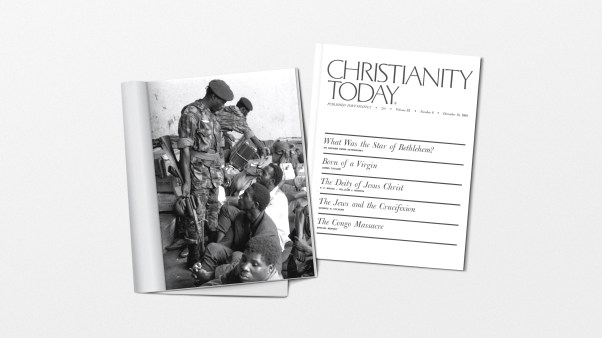Tattoos have become commonplace in modern American culture. According to a 2006 Pew Research Poll, more than one third of Americans between the ages of 18 and 40 have at least one tattoo. Body art has become yet another way for people to express their beliefs and values. Young Christians have joined the trend, emblazoning Bible verses, crosses, or fish symbols on their biceps or ankles. But they are certainly not the first to do so in the history of the church. Some early Christians, including many in Egypt, took the ancient practice of tattooing and infused it with Christian meaning.
Christianity found fertile ground in Egypt in the first few centuries after Christ, and the Coptic church grew and assumed a position of leadership in the late Roman Empire. The great Egyptian city of Alexandria held center stage in many early Christian controversies (including the debate over Christ's divinity), and monasticism began in the deserts of Egypt. By the time Arab Muslims invaded Egypt between 639 and 641, therefore, the vast majority of Egyptians were practicing Christians. Arab conquerors adopted the Coptic word kubti, meaning "Egyptians," which eventually evolved into the name "Copt." So strong was the link between Egyptians and Christianity that the Arabs used the word "Copt" to refer both to their subjects' ancestry and to their religion. To this day, a Copt is a Christian of Egyptian descent living in Egypt or abroad.
Throughout much of Coptic church history, Egyptian Christians have been a minority in their own land. The Arabs invaded Egypt because of its strategic position within the Byzantine Empire as well as its close proximity to natural resources. Within two centuries, the minority Muslim government realized that in order to maintain power they had to make life more difficult for Christians who refused to convert to Islam. They increased taxes on Christians, restricted traditional Coptic dress, and expanded the use of Arabic. Quickly the Copts slipped from majority status into being a persecuted minority.
Slaves of Christ
During these long periods of maltreatment, the Coptic practice of tattooing arose. Ancient (pre-Christian) Egyptian tattooing can be definitively traced back to 2000 B.C. In the Roman Empire, tattooing was a degrading practice used to brand slaves and criminals, and was also sometimes used in pagan religious rites whereby someone became the "slave" of a god. In the fourth century A.D., the Montanists, a Christian sect relying heavily on the Book of Revelation, began tattooing themselves as "slaves of God" (Rev. 7:2-3). The earliest evidence of Coptic tattooing goes back to the eighth-century, when Egyptian monks began to brand their hands with Christian symbols. Some scholars believe they learned the practice from Ethiopian Christians, who branded crosses on their foreheads, temples, and wrists.
Historian Susanna Elm writes that "different kinds of Christians, ascetics, ordinary Christians, and occasionally bishops carried stigmata that signalized in various ways their obedience to God, their 'belonging to God,' even in adverse circumstances." Coptic scholar Otto Meinardus agrees: "In times of persecution, the tattoo of the cross has given strength to the faithful and has made it impossible for them to deny their faith."
Between 1250 and 1517, the Egyptians who remained Christians experienced their most difficult period of persecution. The dictatorial Turkish Mamluk rulers forced Christians into degrading positions, such as riding their donkeys backwards and wearing bells around their necks. Their homes were frequently looted, and they experienced oppression by Muslim princes all over the country. Yet throughout centuries of persecution, the Egyptian church and its people survived. The Copts' professional talents as bookkeepers, administrators, architects, doctors, and craftsmen made them an indispensable part of Egypt's economy and government.
Marks of Distinctiveness
The Copts recognized their need for a strong church hierarchy in order to maintain ecclesiastical authority while living in a dictatorial state. The Coptic church has maintained two distinctive branches of authority: the Patriarch (called "Papa" meaning "pope") acts as the church's spiritual leader and pastor, while the Holy Synod makes decisions on matters of spiritual, ecclesiastical, and economic importance. Yet perhaps the church's most important asset has been it laity. During centuries of Muslim rule, the Copts experienced an erosion of culture. Coptic scholar Theodore Partrick asserts that while Arabic prevailed and Islam expanded, it was predominately Coptic laypeople practicing their traditional faith who kept Egyptian Christianity alive: "It was largely their sense of being different that saved the Copts as a group from the various pressures of the majority."
This general "sense of being different," along with their willingness to publicize their religious distinctiveness, makes Coptic Christians a persistent and dauntless minority (although the BBC notes that as many as eleven million Copts live in Egypt today, making them the largest Christian group in the Middle East). While cross tattoos are no longer widespread among urban Copts, they remain popular among Egyptian Christian villagers as reminders of particular blessings and religious vows. To these Copts of both the past and present, cross tattoos have not been a sign of teenage rebellion or fashion forwardness. Instead, they have been enduring reminders of their Christian faith—showing the Copts' dedication to the One who bore the everlasting scars of mercy, grace, and truth.
Jennifer A. Johnson is a graduate of Bethel Seminary with a concentration in Christian history and currently works as an editor and writer.
Copyright © 2009 by the author or Christianity Today/Christian History & Biography magazine. Click here for reprint information on Christian History & Biography.









